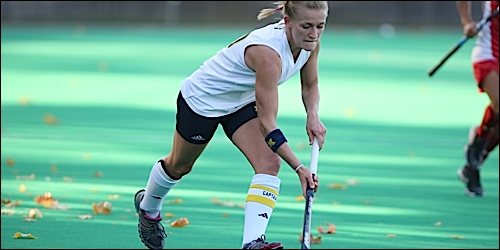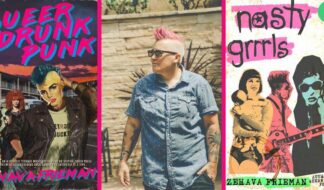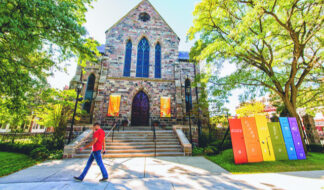By Dan Woog

Steph Hoyer
The OutField
The University of Michigan is a sports-obsessed campus. Big Ten football and basketball games fill the stands; Wolverine paraphernalia can be found everywhere. Academically, one of the most popular courses is "History of College Athletics." With 150 students every semester, and at least as many on the waiting list, the American culture department offering explores important intersections of sports and society, like race and gender.
And now, gay and lesbian athletes.
GLBT issues were not always a part of the syllabus. It took the work of Paul Farber, a Ph.D. candidate, to add that often overlooked segment of sport to the curriculum.
Earlier this decade, Farber was recruited by the University of Pennsylvania track program. A gay man, he left the team after finding little support for gay athletes. "It was hard to choose between my sport and myself," he admits.
Farber turned his energy to founding Penn Athletes and Allies Tackling Homophobia – one of the nation's first GLBT college sports groups.
As a Michigan teaching assistant, he approached John Bacon – the "History of College Athletics" instructor, sportswriter, NPR commentator and expert on Michigan sports – to propose a unit on GLBT athletes. Bacon readily agreed.
Farber sought an out Wolverine athlete to speak. It was not easy.
As soon as the lecture was over, however, a dozen or so athletes told Farber about gay teammates they knew. More of them than he realized were out in small circles, Farber realized. But none had a way of connecting with other gay athletes.
One of Farber's students, Allison Horky, had written a paper on GLBT athletes. She and Farber talked about creating a mechanism to bring Michigan's gay athletes together.
A small working group – composed of student-athletes and others – met. The athletes came from intercollegiate teams like field hockey, men's gymnastics, women's crew and club sports. "It was definitely the minor sports," Farber notes.
A Facebook page helped draw over 100 athletes – gay and straight – to the first meeting. The football team was represented by a few players, both current and past.
Attendees wanted to know the best way to stand up for GLBT athletes. The involvement of straight allies, participants agreed, was crucial.
The group – Michigan Athletes and Allies Partnership (MAAP) – began working with the Student-Athlete Advisory Committees board. "At Penn, we were originally shut down by the athletes' advisory board," Farber says. "They're working together there now. But at Michigan, that early support was key."
MAAP has three main goals: to create awareness around GLBT issues in athletics at the University of Michigan; to establish permanent resources and a support system among student-athletes, coaches, the athletic department and the greater university community; to foster a safe environment for all student-athletes, regardless of sexual orientation and gender identity.
MAAP hopes to provide information on GLBT issues and resources to all student-athletes. It's already included in the freshman athlete orientation packet.
A climate survey is also planned.
Silence is still an obstacle, Farber says. The atmosphere on most teams is still not welcoming to most gay athletes. So unless gay issues are discussed, it's hard for athletes to come out. MAAP's visibility will help that process.
"We want to hear everyone's story," Farber says. "And that includes allies."
Michigan's sports culture helps. "The teams have a large GLBT following," says Farber. "Everyone understands the importance of sports, and wants our teams to be the best. And the athletic department is in the forefront of caring for student-athletes."
One student-athlete that has been helped by MAAP is Steph Hoyer. As a field hockey player, she felt she was in a safe environment. However, she was in a lesbian relationship that was not going well. She didn't feel she could be open with teammates about it. "They just couldn't relate to my struggle," she says.
"My eyes have been opened to this part of athletics – how it's not talked about," says Hoyer. "It shouldn't be hush-hush."
"She thought she was the only one," Farber says. "Now she's getting her story out, and people are coming to her to talk. She's on the SAAC board. The respect people have for her really helps.
"This was a conversation waiting to happen for a long time. With a great group of students and very supportive administrators, we can accomplish a lot.
"I'd love to see MAAP get more integrated into the athletic department," Hoyer says. "Every student-athlete should know we're available for them, and that the athletic department can help. And they should know it without having to search far."










